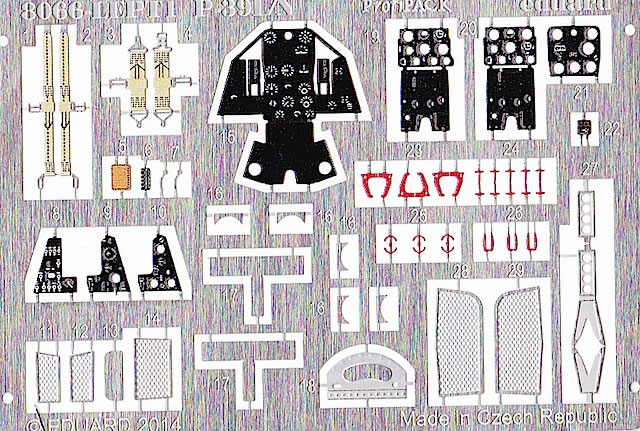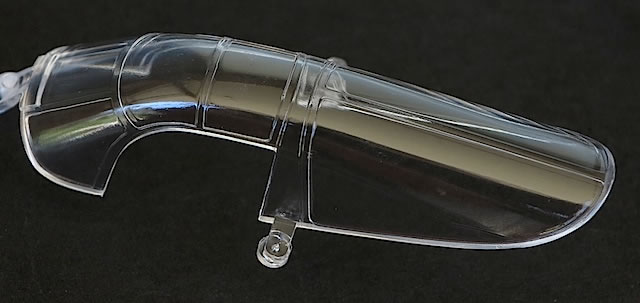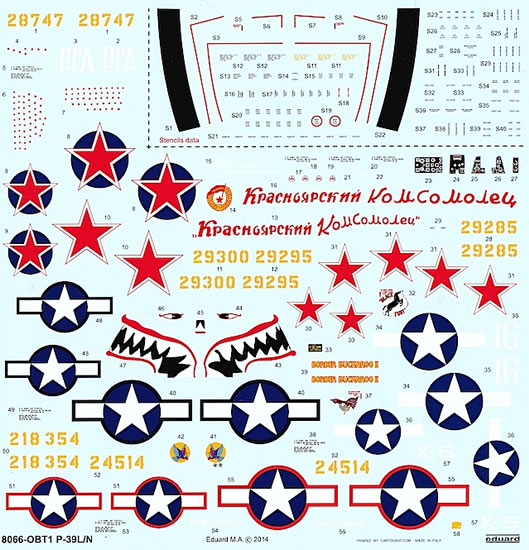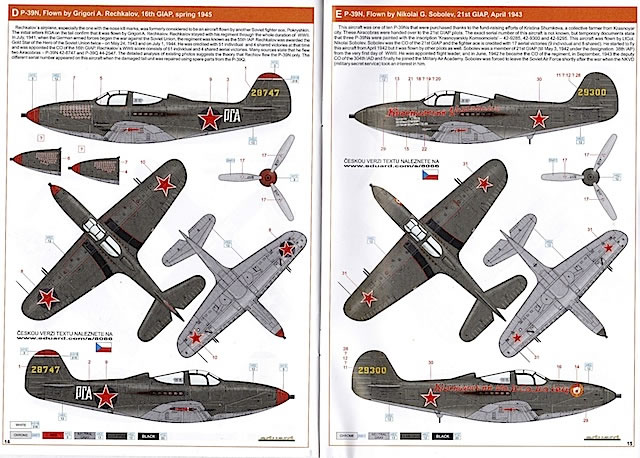|
P-39L/N Airacobra
ProfiPACK

Eduard Limited Edition, 1/48 scale
S
u m m a r y |
| Catalogue Number: |
Eduard Kit No.8066 - P-39L/N Airacobra ProfiPACK |
| Scale: |
1/48 |
| Contents and Media: |
Approximately 126 tan and grey coloured plastic parts (25 unused); 6 clear plastic parts; 1 fret of pre-painted photo-etched brass parts; 1 sheet of die-cut tape masks; 1 decal sheet containing markings for 5 aircraft; 16 page A5 full colour instruction booklet. |
| Price: |
USD$25.46 plus shipping available online from Eduard’s website and specialist hobby retailers worldwide |
| Review Type: |
FirstLook |
| Advantages: |
Sound basic kit, enhanced with colour photo-etched details; interesting marking options and excellent decals. |
| Disadvantages: |
None noted. |
| Conclusion: |
Eduard’s 1/48 P-39 is a sound kit that has stood the test of time. This new P-39L/N boxing is competitively priced and contains a superb decal sheet. If you haven’t tried an Eduard Airacobra before, this kit is a good place to start – highly recommended. |
Reviewed by Brad Fallen

Eduard's Limited Edition 1/48 La-5
is available online from Squadron.com
Just under 10,000 P-39 Airacobras were built between 1938 and 1944, including 250 P-39Ls and 2,095 P-39Ns. These mid-production Airacobras incorporated a number of improvements on earlier P-39s. For example, the P-39L was fitted with nose vents to help dissipate gun gases and a redesigned nose wheel that produced less drag, features that were continued in the P-39N and subsequent versions.
The P-39L and P-39N were similar but not identical. They were powered by slightly different versions of the Allison V-1710 engine, and while P-39Ls had a Curtiss Electric propeller, P-39Ns were fitted with two types of Aeroproducts propellers (one three inches greater in diameter than the other). The P-39N also had smaller internal fuel tanks and (in the final production block) thirty-eight less pounds of armour, with both changes aimed at reducing overall weight.

Eduard’s 1/48 P-39 kit dates back to 2000, and was an important step in the company’s evolution into one of the leading plastic kit manufacturers. The P-39 was a step up from anything Eduard had previously released, and the first new quarter-scale Airacobra since Monogram’s 1960s-era kit. To get a sense of how positively the Eduard P-39 was received, read Caz Dalton’s original 2000 review of the P-400 boxing. 14 years later the kit still holds up very well, notwithstanding Hasegawa’s launch of a 1/48 P-39 series in 2006.
Eduard has made good use of its Airacobra moulds, releasing over ten different Profipack, Dual Combo and Weekend Edition boxings. Accurate Miniatures also produced several P-39 kits based on Eduard’s sprues in the late 2000s. Now Eduard has added a further P-39 boxing to its range, with the April 2014 release of a P-39L/N Profipack.
The first thing to note is that the kit is packed in a small 30 x 20cm (12 x 8 inch) box, the same size that houses Eduard’s 1/48 I-16 kits. This is good because it holds the sprues tightly and prevents any movement, and possible damage, during transport. There are three sprues of plastic parts – two in Eduard’s new dark grey plastic and one in the olive brown plastic the company used until 18 months ago. Despite their heavy use the moulds have held up well over the years: the only flash I could find was a tiny amount on the fuselage halves. Surface detail is petite and while not as refined as that of Eduard’s current kits, it is perfectly acceptable and will look convincing under a coat of paint.
Eduard’s policy of including parts for different variants on the same sprues means about a quarter of the parts are destined for the spares box. This also means that if you have an alternative source of decals, you don’t need to limit yourself to building a P-39L or N. If you are modeling one of the featured machines, the instructions clearly show the parts you need to use – although you should also check photo references, given the extent to which components were mixed and matched in the field. Parts specifically identified for use include:
- The large-hub nosewheel introduced during P-39L production, which like the mainwheels is offered in weighted and unweighted versions;
- The nose scoops that also became standard with the P-39L. These are provided as small separate parts that will need to be carefully glued into position (two on each side of the nose);
- Curtiss Electric propeller blades for the single P-39L (marking option B), and Aeroproducts blades for the P-39Ns. Eduard makes no distinction between the longer and shorter Aeroproducts blades used on P-39Ns, which is acceptable given that in 1:1 scale the difference was three inches. All of the blades are provided as separate units and will require careful alignment, preferably with a jig;
- Different P-39L and P-39N instrument panel configurations;
- Three different types of spinner/nose armament configuration;
- Staggered blast tubes for the four .30 caliber wing guns; and
- Radio masts for options A and B.
As this is a Profipack boxing, the plastic parts are enhanced with photo-etched details and a sheet of pre-cut canopy and wheel masks; the latter is welcome given the curves and panels of the P-39 canopy. Most of the pre-painted photo-etched parts supplied are destined for the cockpit, where they will enhance the already detailed plastic parts and be highly visible through the canopy and doors. Photo-etched parts are also used to depict the grills inside the wing leading edge intakes.

One item that’s been included in some previous Eduard P-39 kits but is absent here is a nose weight. Don’t forget to add sinkers or shot in the nose cavity during assembly, or you’ll end up with a tail-sitter.

The 16-page A5 instruction booklet is printed in full colour and provides a well-illustrated, step-by-step guide to construction. As mentioned above, optional parts are clearly identified, but make sure you pay close attention as you proceed because some of the panels are quite busy.
Full-colour, four-view drawings are included for each marking option, along with a frontal view of the spinner and propeller blades. A four-view grayscale stencil guide is also provided on the final page of the booklet.
Marking Options
Markings are included for four P-39Ns and one P-39L as follows:
-
P-39N-1-BE, serial no. 42-18354, which according to the instructions belonged to the 345th Fighter Squadron/350th Fighter Group in North Africa and Sardinia in late 1943. This aircraft, along with options C, D and E, was camouflaged in Olive Drab over Neutral Gray – in this case set off by a dramatic shark’s mouth, red spinner and white tips to the upper wings and vertical tail.
-
P-39L-1-BE, ‘Wild Flower’/serial no. 42-4514, 91st FS/81st FG, Tunisia, September 1943. Eduard’s camouflage suggestion for ‘Wild Flower’ is Olive Drab, Dark Earth, and Middle Stone on the upper surfaces, and Azure Blue on the lower surfaces – although the instructions acknowledge this interpretation is based on black-and-white photographs and therefore conjectural.
-
P-39N, ‘Border Buckaroo II’/serial no. unknown, flown by Lt. DeVore, 110th Tactical Reconnaissance Squadron, 71st Tactical Reconnaissance Group, New Guinea, Spring 1944. ‘Border Buckaroo II’ sported the white wing leading edges and tail surfaces carried by many Allied aircraft in New Guinea during this period.
-
P-39N, RGA/serial no. 42-8747, flown by Grigori A. Rechkalov, 16th GIAP, Spring 1945.
-
P-39N-1, ‘Krasnoyarskiy Komsomolets’/serial no. 42-9300, flown by Nikolai G. Sobolev, 21st GIAP, August 1943. This Soviet machine carried slogans along a good portion of both fuselage sides.
The decals are by Cartograf and as always with products from this company, look superb on the sheet.

Printing appears to be near perfect, with crisp colour demarcations on even the smallest unit insignia. Stencils are included, as are the wing walks although my preference would probably be to mask and spray the latter instead. The slogans for option E are provided as single long decals, which it may be prudent to slice into smaller parts before applying.

The instrument panels are provided as decals for anyone not comfortable with using photo-etched parts.
Eduard’s 1/48 P-39 is a sound kit that has stood the test of time. Earlier releases are readily available at swap meets, often for excellent prices, but this new P-39L/N boxing is also competitively priced and contains a superb decal sheet. If you haven’t tried an Eduard Airacobra before, this kit is a very good place to start – highly recommended.
Reference
Bert Kinzey, P-39 Airacobra in Detail (Squadron Signal/Detail and Scale, 1999).
Thanks to Eduard for the sample
Review Text and Images Copyright © 2014 by Brad Fallen
Page Created 4 July, 2014
Last updated
4 July, 2014
Back to HyperScale Main Page
Back to Reviews Page |
